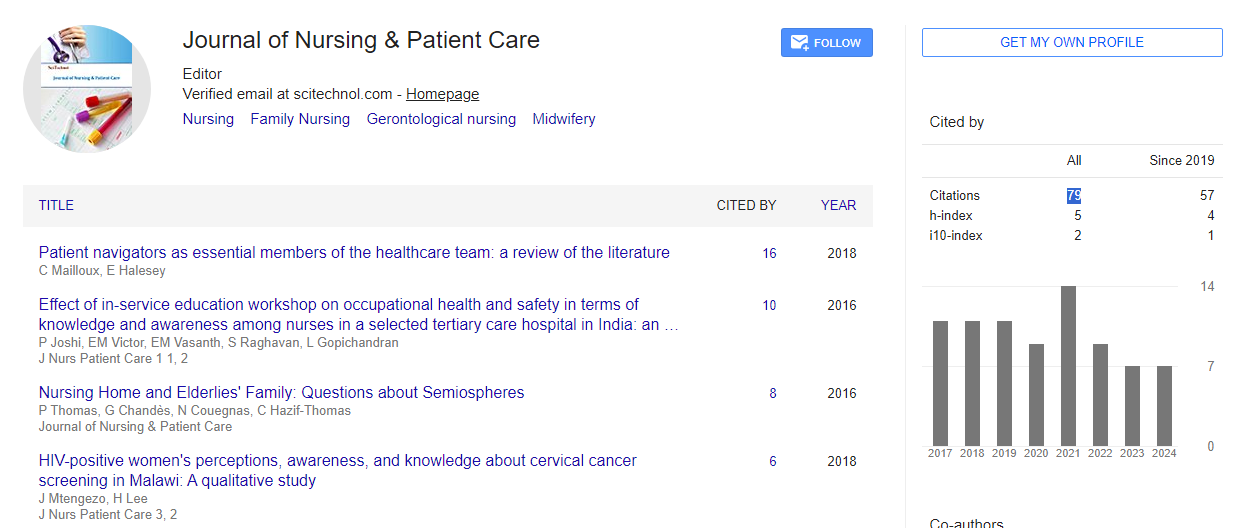Perspective, J Nurs Patient Care Vol: 9 Issue: 2
Telehealth in Pediatric Nursing: Opportunities and Challenges
Riza Mansoor*
1Department of Nursing, University of Bisha, Bisha, Saudi Arabia
*Corresponding Author: Riza Mansoor,
Department of Nursing, University of
Bisha, Bisha, Saudi Arabia
E-mail: manssor@riza.co
Received date: 28 May, 2024, Manuscript No. JNPC-24-140255;
Editor assigned date: 30 May, 2024, PreQC No. JNPC-24-140255 (PQ);
Reviewed date: 13 June, 2024, QC No. JNPC-24-140255;
Revised date: 21 June, 2024, Manuscript No. JNPC-24-140255 (R);
Published date: 28 June, 2024, DOI: 10.4172/2573-4571.1000057.
Citation: Mansoor R (2024) Telehealth in Pediatric Nursing: Opportunities and Challenges. J Nurs Patient Care 9:2.
Description
Telehealth, the use of digital communication technologies to deliver healthcare services remotely, has transformed pediatric nursing by expanding access to care, improving patient outcomes, and enhancing efficiency. In recent years, telehealth has gained prominence as a valuable tool in pediatric nursing practice, offering a range of opportunities and challenges that impact both healthcare providers and families. Telehealth facilitates access to specialized pediatric healthcare services, particularly in underserved or rural areas where access to pediatric specialists may be limited.
Through virtual consultations, pediatric nurses can collaborate with specialists to diagnose and manage complex medical conditions, provide second opinions, and develop comprehensive treatment plans. This improves continuity of care and ensures that children receive timely interventions regardless of their geographic location. Telehealth platforms enable pediatric nurses to engage with patients and families through virtual visits, educational sessions, and remote monitoring tools. Nurses can educate parents on pediatric health topics, demonstrate caregiving techniques, and empower families to participate actively in their child's care management. By caring for partnership and shared decision-making, telehealth enhances parental confidence and promotes attatchment to treatment plans, ultimately improving health outcomes for pediatric patients.
Telehealth supports early intervention and developmental screening initiatives by enabling pediatric nurses to conduct virtual assessments and evaluations. Nurses can remotely monitor developmental milestones, screen for developmental delays, and initiate timely referrals to early intervention services or specialty care providers as needed. Early identification and intervention are critical for optimizing developmental outcomes and addressing potential health disparities among pediatric populations. For children with chronic conditions or complex medical needs, telehealth ensures continuity of care between clinic visits or hospitalizations. Pediatric nurses can conduct follow-up consultations, monitor treatment progress, and address concerns or questions from families in real-time. This proactive approach reduces the likelihood of hospital readmissions, promotes medication adherence, and supports ongoing management of chronic conditions, enhancing overall pediatric health outcomes.
Challenges in implementing telehealth in pediatric nursing
Access to reliable internet connectivity, digital devices, and telehealth platforms can pose challenges for families, especially those in rural or low-income communities. Technological barriers may limit the accessibility and effectiveness of telehealth services, impacting the ability of pediatric nurses to deliver equitable care to all patients. Maintaining patient privacy and confidentiality is paramount in telehealth practice. Pediatric nurses must adhere to strict guidelines and protocols to safeguard sensitive health information during virtual consultations, electronic communications, and remote monitoring activities. Addressing privacy concerns and ensuring secure telehealth platforms are essential for building trust and compliance among patients and families.
Virtual assessments via telehealth may present challenges in accurately assessing certain pediatric conditions, such as physical examinations, diagnostic procedures, or behavioral observations. Pediatric nurses must navigate limitations in clinical assessment tools and techniques, relative on effective communication skills, detailed histories, and collaborative partnerships with healthcare providers to make informed clinical decisions and recommendations. Navigating regulatory frameworks and reimbursement policies for telehealth services can be complex for healthcare organizations and providers. Pediatric nurses must stay informed about licensure requirements, scope of practice guidelines, and insurance coverage policies related to telehealth practice. Advocating for policy changes and advocating for policy changes and advocating for policy changes and advocating.
Conclusion
Telehealth represents a transformative opportunity for pediatric nursing to enhance access, engagement, and continuity of care for children and families. While challenges such as technological barriers and regulatory complexities must be addressed, the potential benefits of telehealth in improving pediatric health outcomes and optimizing healthcare delivery underscore its importance in shaping the future of pediatric nursing practice. By embracing telehealth innovations and overcoming implementation challenges, pediatric nurses can continue to provide compassionate, high-quality care that meets the evolving needs of pediatric patients and their families.
 Spanish
Spanish  Chinese
Chinese  Russian
Russian  German
German  French
French  Japanese
Japanese  Portuguese
Portuguese  Hindi
Hindi 